ZEN MESTEREK ZEN MASTERS
« Zen főoldal
« vissza a Terebess Online nyitólapjára
黙庵霊淵 Mokuan Reien (?-1345)
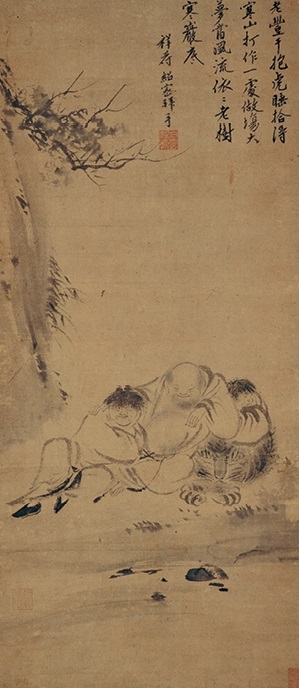
四睡図 Shisui (The Four Sleepers =
Bukan, Kanzan, Jittoku, and the Tiger)
73.4 × 32.4 cm
Maeda Ikutokukai (前田育徳会), Tokyo
The painting bears a seal of the artist and a colophon reading as follows:
老豊干抱虎睡拾得寒山打作一處
做場大夢當風流依々老樹寒巌底
Old Feng-kan embraces his tiger and sleeps,
All huddled together with Shih-te and Han-shan
They dream their big dream, which lingers on,
While a frail old tree clings to the bottom of the cold precipice.
Shao-mu of the Hsiang-fu [temple] salutes with folded hands.
(Tr. by J. Fontein and M.L. Hickman)
Old Bukan hugging his tiger asleep
huddling together with Kanzan and Jittoku
had a dream, as though experienced the highpoint of life
lingering is the old tree clinging to the bottom of a cold rock
(Tr. by Leo Shing Chi Yip)
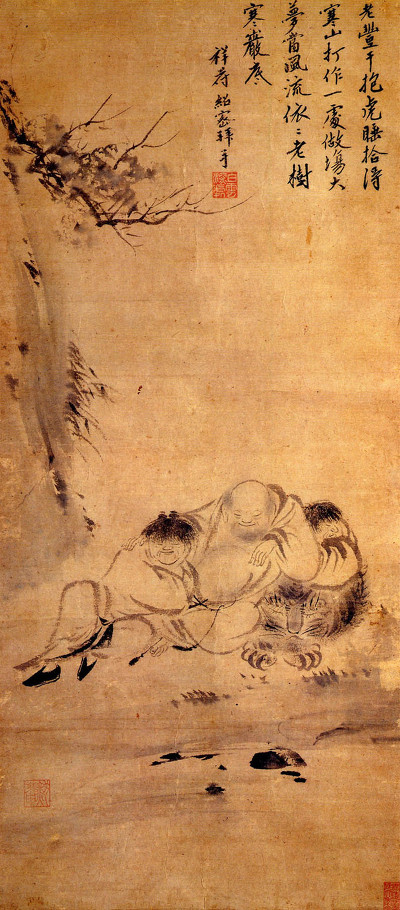
Kanzan Jittoku 寒山・拾得
Ch: Hanshan Shide. Semi-legendary Tang dynasty, Zen 禅 (Ch: Chan) eccentrics who were frequently depicted in Chinese and Japanese ink painting. Kanzan 寒山 (Ch: Hanshan; lit. cold mountain) is thought to have lived as a poet-recluse near Mt. Tiantai (Jp:Tendai 天台 ) in Zhejiang 浙江 . Jittoku 拾得 (Ch: Shide; lit. foundling) was so named because he was found by the Zen master Bukan 豊干 (Ch: Fenggan) and raised in the Tiantai temple Guoqingsi 国清寺, where he worked in the kitchen and gave leftover food to his friend Kanzan. The little that is known of their biographies is provided in the preface to a collection of Kanzan's poetry, Cold Mountain KANZANSHI SHISHUU 寒山子詩集 (Ch: Hanshanzishiji) and the KEITOKU DENTOUROKU 景徳伝灯録 (Ch: Jingde Chuancenglu) compiled in 1004. Kanzan Jittoku were regarded later as incarnations of the bodhisattvas Monju 文殊 (Sk: Manjusri and Fugen 普賢 (Sk: Samantabhadra), respectively. They are usually depicted with ragged clothing, long, tangled hair, and grimacing or laughing wildly. Kanzan frequently holds a scroll, presumably of his poetry although several painting inscriptions claim it is devoid of writing, while Jittoku holds a broom, indicating his position as a scullion. Along with Bukan and his pet tiger, they make up the shisui 四睡 (four sleepers).
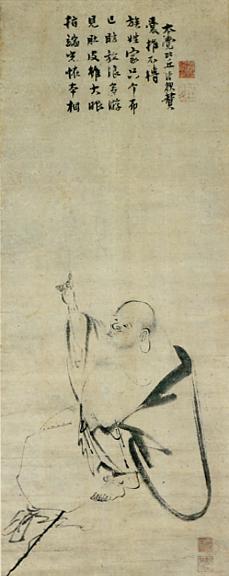
布袋図 Hotei
by Mokuan Reien, bearing a poetic encomium (zan 贊) by the Chinese Chan-master, Liao'an Qingyu 了庵清欲 (1288–1363)
80.2 × 32 cm
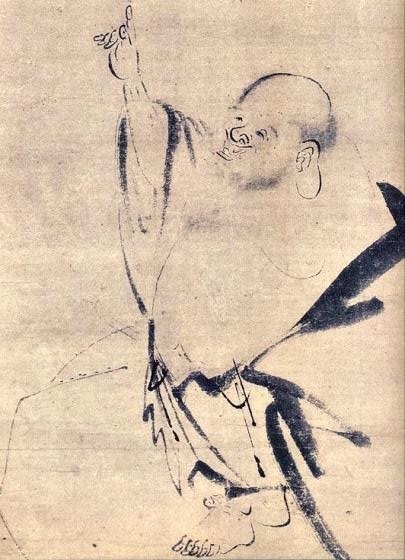
Mokuan Reien was a Zen priest who went to China in the early 14th century and never returned home. In China he visited Liutong Temple in the West Lake area where he was heralded as the incarnation of Mu Qi. Later he became a zōsu, or a monk in charge of supervising the repository for sutras under Priest Liaoan Qingyu at Benjue Temple from 1333 through 1343. As this painting has Liaoan Qingyu's commentary, it is thought to be the work from around this period. The theme is a legendary Zen monk Hotei, pointing toward heaven to prophesize the coming of Miroku, the Buddha of the future.
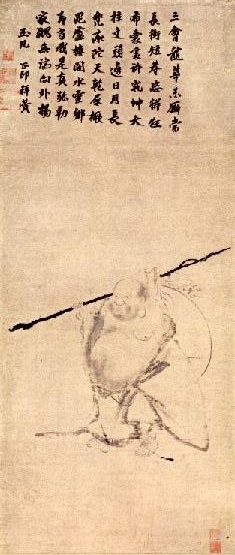
布袋図 Hotei
114.2 × 48.8 cm, Sen-oku Hakuko Kan (Sumitomo Collection)